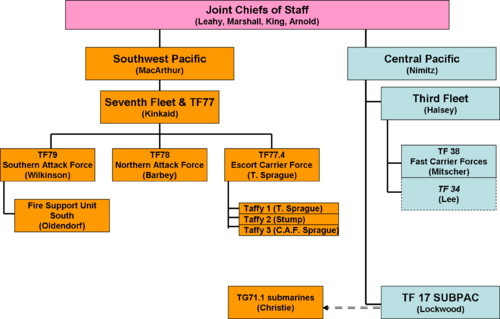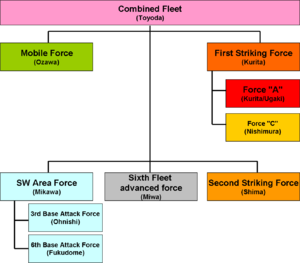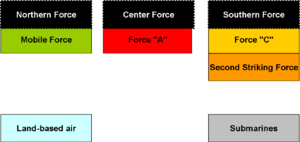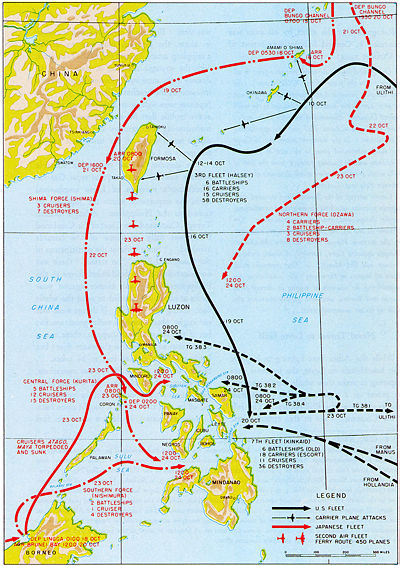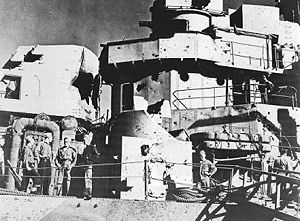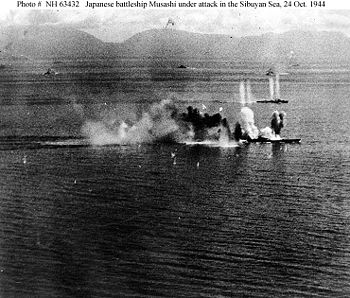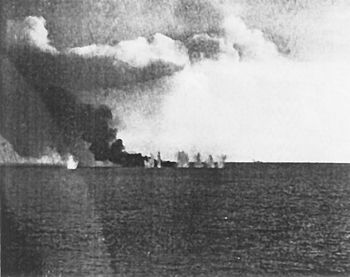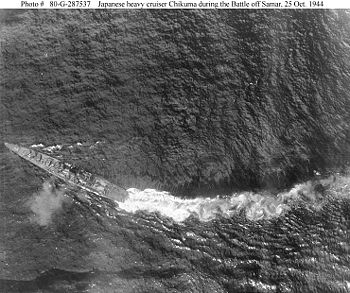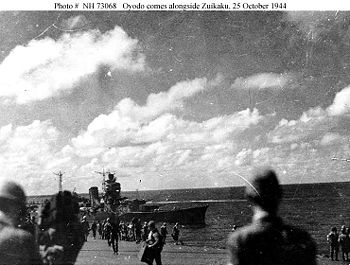Battle of Leyte Gulf
The Battle of Leyte Gulf (October 23-26, 1944) was the largest naval battle in world history and the last major sea battle of World War Two. It was fought in the seas around and to the east of the Philippine Islands between the Japanese Imperial Navy and Allied naval forces. The battle occurred in reaction to and defense of the Allied invasion of Leyte.
Both sides suffered from divided command. In his autobiography, Fleet Admiral William Halsey, wrote,
If we had been under the same command, with a single system of operational control and intelligence, the Battle for Leyte Gulf might have been fought differently to a different result. It is folly to cry over spilled milk, but it is wisdom to observe the cause, for future avoidance. When blood has been spilled, the obligation becomes vital. In my opinion, it is vital for the Navy never to expose itself again to the perils of a divided command in the same area.[1]
Divided command was implicit in the Pacific, with the Joint Chiefs of Staff decision to split the strategic command between Chester Nimitz's Pacific Ocean Areas and Douglas MacArthur's Southwest Pacific Area,[2] but this split was at the operational level of command.
| Halsey as a source
Unquestionably, one of the great controversies of the Battle of Leyte Gulf was responsibility for the Center Force reaching the Samar area, and Fleet Admiral William Halsey (a vice admiral in the battle) has defended his decisions. His 1947 autobiography, which originally appeared as magazine installments, retained "a good deal of the original dictated narrative, sometimes at the expense of unity and in defiance of chronology. The result catches Halsey's personality strikingly; the reader almost seems to hear the admiral talking."[3] It did, however, make an "implacable enemy" of Thomas Kinkaid, [4] in spite of writing, in the autobiography, "I have attempted to describe the Battle for Leyte Gulf in terms of my thoughts and feelings at the time, but, on rereading my account, I find that this results in an implication grossly unfair to Tom Kinkaid. True, during the action, his dispatches puzzled me, Later, with the gaps in my information filled, I not only appreciate his problems, but frankly admit that had I been in his shows, I might have acted precisely as did he."[1] |
In postwar interrogation, Vice Admiral Jisaburo Ozawa, respected by both sides as a highly intelligent officer, said of the Phillipines plan," Before the plan worked out, I knew it was very hard and complicated plan so that I was not surprised by events; but under the circumstances, there was no other method of procedure. The lack of air power, I feel, was the weakest point. I knew in advance that lack of air power was the main drawback to the operation."[5]
American situation
U.S. Pacific strategy derived from Joint Chiefs of Staff decisions at the Cairo Conference (1943), to obtain "bases from which the unconditional surrender of Japan can be forced."[6] There was, however, little clarity and much argument among the JCS and the two theater commanders, Douglas MacArthur for the Southwest Pacific Area and Chester Nimitz for the [Central] Pacific and Pacific Ocean Areas. JCS guidance to Nimitz and MacArthur, dated 12 March 1944, reflected what was to become an obsolete concept: "The JCS has decided that the most feasible approach to Formosa, Luzon and China is by way of the Marianas, Luzon and China."
Events were to make Formosa, Luzon and China infeasible as the final bases for attacks on the Japanese home islands. In May 1944, the Japanese Army, moved into Eastern China. After this, the JCS suggested considering bypassing all the intermediate bases and directly attacking Kyushu, the target, much later, of Operation OLYMPIC.[7] This suggestion outraged MacArthur, but it reflected the desire of Army Chief of Staff George C. Marshall not to embark on unnecessary land campaigns; MacArthur was told that that personal and political considerations should not override the goal of defeating Japan.Marshall had also been an advocate of a very early cross-Channel invasion in the European theater.[8]
Since leaving the Phillipines in 1942, "The Philippine Islands constituted the main objective of General MacArthur's planning from the time of his departure from Corregidor in March 1942 until his dramatic return to Leyte two and one half years later". [9]MacArthur and his staff responded, on 15 June 1944, with the Reno V plan, which called for an October invasion of Mindanao to cover a November invasion of Leyte, and further movements on a line Luzon-Bicol Peninsula-Mindonoro-Lingayen Gulf-Manila. Admiral King, and even MacArthur's air commander, General Kinney, criticized it.
Eventually, President Franklin D. Roosevelt intervened to break the deadlock between King and Nimitz versus MacArthur. Roosevelt traveled to Honolulu, accompanied by his chief of staff, Admiral Leahy, and met with MaCarthur in July. [10]
Concept of operations
MacArthur had a deep emotional bond to the Phillipines, and both believed the honor of the United States required their liberation and that such an approach was strategically sound. He saw Leyte as the base from which the rest of the Phillipines could be taken. [11] Third and Fifth Fleet staff agreed on three naval objectives in support of land operations:[12]
- Air strikes on Okinawa, Formosa, and Northern Leyte on 10-13 October, by Third Fleet and long-range land-based aircraft
- Attacks on Bicol Peninsula, Leyte, Cebu and Negros, and direct supports of the actual landings, 16-20 October; this was the Seventh Fleet role
- "Strategic support" from 21 October onwards. This was the principal Third Fleet role, and an ambiguous one
Preparatory steps
On 9-10 September, Third Fleet units, supporting impending landings on Morotai and Palau, made air strikes on Mindonoro, and discovered significant weaknesses in Japanese air defense. ving , hit Mindanao and discovered unexpected and serious weakness in the enemy's air defenses of that area. It was determined that Southwest Pacific land-based bombers, operating out of New Guinea fields, had caused severe damage to enemy air installations on the island. Exploiting the weakness, the Third Fleet raided the Visayas on 12-13 September, causing substantial damage to aircraft and airfields. [13]
MacArthur chose to occupy Morotai Island, off Halmahera, as an intermediate base, with landings starting on 15 September by the U.S. Army 31st Division and 126th Regimental Combat Team of the 32nd Division plus supporting combat and service troops, directed by XI Corps. Simultaneously, the 1st Division, U.S. Marine Corps, followed by the Army's 81st Division, took Palau and Angaur in the Palau group. Ulithi was taken on the 23rd.[14]
Morotai and Palau, 350-500 miles from Leyte, became the main bases for Army fighters, still distant for WWII aircraft. Ulithi became the main staging harbor.
Command structure
United States Third Fleet under Admiral William Halsey reported to Admiral Chester Nimitz, and had the roles of defeating the major Japanese fleet and taking the islands of the Central Pacific. To increase the tempo of operations, the same ships were Third Fleet when under Halsey and his staff, and Fifth Fleet when under Admiral Raymond Spruance. Spruance and Halsey, without friction, alternated in planning and executing operations.
The Joint Chiefs in Washington had never been able to agree on a single commander for the Pacific. Nevertheless, the Third and Seventh Fleets were standing organizations that had reasonable internal communications.
Seventh Fleet mission
Under MacArthur, the Seventh Fleet, commanded by Vice Admiral Thomas Kinkaid (commander, Allied Naval Forces, Southwest Pacific Area) had the mission of landing and supporting the landing force. [15] Although code names were less frequently used to describe Pacific operations, the Seventh Fleet plan was designated Operation MUSKETEER/Operation KING V. Kinkaid's flagship was the amphibious command ship USS Wasatch (AGC-9), where he was accompanied by the Commander of the Sixth United States Army, Lieutenant General Walter Krueger. Kinkaid's deputy, VADM Thomas Wilkinson, was on the secondary flagship, command ship USS Olympus (AGC-8), which also commanded the Southern Attack Force. MacArthur's seagoing headquarters was on the cruiser USS Nashville.
Northern Attack Force, under RADM Daniel Barbey aboard USS Blue Ridge (AGC-2), was to land the X Army Corps under MG F.C. Sibert.
Southern Attack Force carried XXIV Army Corps under MG J.R. Hodge. Transport task groups carried divisions. Fire Support Unit South was made up of old battleships and other heavy gunships under RADM Jesse Oldendorf, and TG 77.4, the Escort Carrier Group, was under RADM Thomas Sprague.
Third Fleet
Third Fleet was led by Vice Admiral William "Bull" Halsey, whose flagship was the battleship USS New Jersey (BB-62). At the time of this battle, his chief of staff was Rear Admiral Robert B. "Mick" Carney, who replaced the brilliant but erratic Captain Miles Browning, a Halsey favorite.[3]
Organization
Reflecting the alternation of the top command between Halsey (Third Fleet) and Spurance (Fifth Fleet), there were two major type-specific task forces, not necessarily acting as an active command level in a particular engagement.
- TF 38/TF 58: Fast Carriers Pacific Fleet, under VADM Marc Mitscher
- TF 34/TF 54: Battleships Pacific Fleet, under VADM Willis Lee
While it was not always the case, TF38 and Third Fleet were identical from September 1944 on. Halsey turned to Mitscher to direct the air operation when the mission was principally air, such as the raid on Formosa, while Halsey assigned targets and directed surface ship movements. [16] During the Battle of Leyte Gulf, however, Halsey routinely issued orders to the task groups of TF 38, bypassing Mitscher. [17]
The carriers, battleships, and lighter ships primarily were distributed into four task groups
| ID & CO | Fleet carrier | Light carrier | Battleship | Heavy cruiser | Light cruiser | Destroyer |
|---|---|---|---|---|---|---|
| TG 38.1
VADM John McCain Sr. |
2 | 2 | 0 | 0 | 0 | 15 |
| TG 38.2
RADM Gerald Bogan |
3 | 3 | 1 | 0 | 3 | 17 |
| TG 38.3
RADM Frederick Sherman |
2 | 2 | 4 | 0 | 4 | 14 |
| TG 38.4
RADM Ralph Davison |
2 | 2 | 4 | 1 | 1 | 11 |
Mission
There was much more ambiguity in the mission of Vice Admiral William Halsey's Third Fleet. Nimitz directed him to "cover and support" SWPA forces "in order to assist in the seizure of all objectives in the Central Phillipines", and to "destroy enemy naval and air forces in or threatening the Phillippines area." This was consistent with orders given to Spruance's Fifth Fleet in the Marianas operation.
An additional sentence in Halsey's orders, however, was "In case opportunity for destruction of major portion of the enemy fleet is offered or can be created, such destruction becomes the primary task". Friedman refers to Potter's biography of Nimitz, observing that the paragraph was not numbered as were the others, and not in the writing style of Nimitz or of Chief of Naval Operations Ernest King.[18] Nevertheless, in September, Halsey had written to Nimitz,
I intend, if possible, to deny the enemy a chance to outrange me in an air duel and also do deny him an opportunity to deploy an air shuttle[19] against me.
Inasmuch as the destruction of the enemy fleet is the principal task, every weapon must be brought into play and the general coordination of these weapons should be in the hands of the tactical commander responsible for the outcome of the battle [emphasis added]]...My goal is the same as yours — to completely annihilate the Jap fleet if the opportunity offers.[20]
Referring to the underlined section, it is unclear who Nimitz would consider the tactical commander, and whether there was an overall tactical commander for the entire Leyte campaign. Twelve days before the landings, Nimits wrote to Halsey,
You are always free to make local decisions in connection with the handling of forces under your command. Often it will be necessary for you to take action not previously contemplated which may develop quickly and may not yet be available to me. My only requirement in such cases is that I be informed as fully and as early as the situation permits.[21]
Halsey, more aggressive than his friend Spruance, interpreted that in his own operation order: "If opportunity exists or can be created to destroy major portion of the enemy fleet, this becomes primary task.[22] This is the classic Mahanian goal, shared by Halsey's opponents, especially VADM Takeo Kurita. Halsey's decisions remain active arguments among naval historians, although more tend to believe he lost sight of the most important mission.[17] Halsey also issued a battle plan, which he did not consider an order, saying that a surface gunfire force "will be formed as TF 34 under VADM Lee, Commander Battle Line. TF 34 will engage decisively at long ranges." It was his intention to have this treated as a warning order for the action "if a surface engagement offered. As confirmation, he pointed out his subsequent radio message, "If the enemy sorties [through San Bernadino], TF 34 will be formed when directed by me."[23]
Confusion about Third Fleet mission and organization, however, was not restricted to Halsey's command. Both Nimitz and Kinkaid, however, were uncertain if TF 34 was operating as a single unit, generally assuming that it was, and called for Lee's assistance during the Action off Samar.[24] Lee might have formed TF 34 as Battle Line had Halsey engaged Ozawa's force with a surface gunfire action, but, as a result of the problems in San Bernadino Strait, Halsey called off that action.
Confusion between Halsey and Kinkaid, including Halsey's priority of attacking the Japanese carrier force, led to San Bernadino Strait not being covered and the Action off Samar decided by the desperate fighting of light vessels of the Seventh Fleet. See the Action off Samar for details of communications and miscommunications.
Japanese situation
As with the U.S. forces, the only common command was at the national capital. Admiral Soemu Toyoda directed a number of units, which had extremely poor coordination — even rivalry — with one another.
The U.S., however, did not understand either the actual Japanese organization, or that the Mobile Force's role was that of a sacrificial decoy.
Concept of operations
At first, the Japanese concept of Operation SHO-GO sought the Mahanian "decisive battle" of major fleet units. A series of SHO-GO "Victory Operation") operational plans were developed by Imperial General Headquarters (IGHQ) and Combined Fleet, with contingencies for the invasion coming at various points in the Philippines, or Formosa, Honshu-Kyushu, and Hokkaido-Kuriles.[25] IGHQ developed policy and Combined Fleet issued the operational orders. [26]
Command structure
The U.S. had a poor understanding of the Japanese command structure, sometimes looking for complex strategic reasons when the positioning of a unit was simply due to fuel supply. MacArthur's Air Evaluation Board after the war, "Enemy intentions rather than capabilities were prominent [in U.S. planning]]." [27]
Mobile Fleet
The carrier-centric Mobile Fleet, under Vice Admiral Jizaburo Ozawa, had stayed in the Inland Sea of Japan, training new air groups. Due to its proximity to Combined Fleet, and the high regard in which Ozawa was held, even by his American interrogators after the war, he was an important adviser to Toyoda.
Still, Ozawa had limited authority and information. When asked if he knew who commanded the U.S. forces, he replied "I do not remember who I thought was your commander in chief at that time; there was at the time some estimate but I do not remember. " H[5]
First Striking Force
Vice Admiral Takeo Kurita, was in overall command of the First Striking Force. It was based in Lingga Roads, near Singapore, to be near its fuel supply. Coincidentally, Lingga Roads was closer to India, and the British interpreted this as a threat to it, which led them to hold forces there. [28] Whether this really kept British contributions out of the U.S. Pacific Fleet is debatable, since Admiral Ernest King, U.S. Chief of Naval Operations, was anti-British and was reluctant to include their forces under any conditions.
Interrogated by the U.S. Strategic Bombing Survey in 1945, Kurita was described as "somewhat on the defensive, giving only the briefest of replies prior to the discussion of [the Leyte campaign actions]. In some instances his memory for details such as times, cruising dispositions, etc. appeared to be inaccurate." [29] In a 1977 interview, however, he said he chose not to pass through San Bernadino Strait and attack the transports.
What had we come this far for? Bringing so many ships, and also losing so many ships - wasn't it in order to win a victory at Leyte? I thought that, if the reported task force was 30 miles north east of us, we could definitely catch it. I thought it went without saying to steer towards the enemy force that was stronger.... After all, what lay to the south of us was just a collection of soldiers.... Naval war consists of warships sinking warships. Transport shipping is an opponent for land forces to deal with, isn't it? [30]
Force A
The main body of the First Striking Force had two sections. First Section, under Kurita, was centered on Vice Admiral Matome Ugaki's Batdiv (Battleship Division) 1, the extremely modern IJN Yamato and IJN Mogami, and also IJN Nagato. Second Section under VADM Yoshio Suzuki had Batdiv 3, commanded by Suzuki, with IJN Kongo and IJN Haruna. Both sections had substantial cruiser and destroyer screens.
Force C
Vice Admiral Shigeo Nishimura, commanding Force C of the First Striking Force, was a respected "sea dog", unusual in never having served in a shore command and,having passed the exams, but not taken the Staff College course. [31] It was a relatively weak force, built around two old battleships, IJN Yamashiro and IJN Fuso, heavy cruiser IJN Mogami, and four destroyers, including IJN Shigure.
Commander Shigeru Noshino, captain of IJN Shigure, was the only surviving commander of Nishimura's Force C. He said "The first job was to attack the transport force. If we were fully occupied with that we would not bother with the warships. The primary mission was to destroy the transports." With respect to relations between Nishimura and Shima, his opinion was "To the best of my knowledge Nishimura was older than Shima and had more naval and battle experience, in spite of that Shima was his superior; probably nothing more than a personal antipathy. In my opinion, however, we should have joined forces...[Nishimura] was an old destroyer man. I never met Nishimura personally, but it was said of him that he was clever and a capable Navy man. I will say this much, though, that there are some people who think Nishimura was very fortunate not to have returned from this battle. " [32]
Second Striking Force mission
The Second Striking Force was made up of cruisers and destroyers, under VADM Kiyohido Shima. As opposed to Nishimura, Shima had spent much of his career in administrative posts. Thomas Cutler speculates that one reason not to merge the forces was that the less combat-experienced Shima was senior to Nishimura.[33] Shima and Mizawa fought over authority. [34]
Land-based aviation
Japanese aviation in the Phillippines had both Navy and Army components. Morison describes it as coordinated loosely by Vice Admiral Gunichi Mizawa,[35] who was relieved, for reasons of health, by Vice Admiral Denshichi Okochi in November 1942, after the Battle of Leyte proper.
Hoyt mentions the First Air Fleet, under Admiral Teraoka, had moved its headquarters to Clark Field. [36] After an inspection trip on October 13, Admiral Toyoda replaced Teraoka with Vice Admiral Takijiro Ohnishi and initially made him responsible for the air aspects of the SHO operation.
Fifth Base Air Force, commanded by Vice Admiral Heigo Tominaga and then Vice Admiral Ohnishi, was the Naval aviation organization specifically responsible for the Phillipines. Its Army counterpart was Fourth Air Army, led by Lieutenant General Kiyoji Tominaga. All were headquartered in Manila. Sixth Base Air Force, under Vice Admiral Fukudome, was responsibble for southern Kyushu, the Ryukyus, and Formosa. It had a primarily reinforcing role.
Fukudome was senior to Ohnishi so took control of their merged organization. [37]
As the battle developed, the role of the kamikaze, of which Vice Admiral Ohnishi was the chief advocate, was increasingly important.
Submarines
Japanese submarines did not play a major role, but even there, there was divided command. Vice Admiral Shigeyoshi Miwa, based at Kure in Japan, headed the Japanese Sixth Fleet of fleet submarines. Midget submarines during this battle, however, were under Vice Admiral Mikawa. [38]
He assigned seven submarines in the sector between northeast and southeast of Leyte and three off Lamon Bay. Three arrived on 25 October and the remainder on the 26th, playing little part in the battle. Morison thought he had eleven, but it is clear that they only sank the destroyer escort USS Eversole while it searched for survivors of the Action off Samar. [39]
The battle
By the time landings had started, the most crucial Japanese objective was to attack the transports and other Seventh Fleet ships. They planned a two-pronged attack, through Surigao Strait and through San Bernadino Strait; the latter passes Samar. Their main body was Kurita's Force A within the First Striking Force. Two uncoordinated forces were to try to approach through Surigao Strait, Nishimura's Force C and Shima's Second Striking Force. Meanwhile, Ozawa was to continue acting as a decoy to divert Third Fleet away from the Japanese attack forces.
While the term operational art, or actions intended to specify where battle will take place, was not yet in wide use, it was at the operational level where some of the worst decisionmaking took place. [40] Examples include Halsey leaving San Bernadino Strait unguarded while Kinkaid assumed that he had it protected, Kurita choosing not to break through at Samar. Ozawa's decoying of Halsey was an example of successful operational art.
At the strategic level, the U.S. objective was the capture of Leyte. The Japanese objective was to repel it. Operationally, however, some of the strongest forces of each side had the enemy's carriers as a center of gravity. The Emperor said,
Contrary to the views of the Army and Navy General Staffs, I agreed to the showdown battle of Leyte thinking that if we attacked at Leyte and America flinched, then we would probably find room to negotiate. [41]
It is unclear what the Japanese would have done had the pincer against the invasion transports worked, when they still considered Third Fleet a primary objective. [42] Robinson mentions Morison's observation that it was unclear what they would have done had they successfully decoyed Halsey from the invasion beaches. They did not have the land-based air strength to attack Third Fleet. [43] Possibly, they saw kamikaze tactics as sufficient to defeat Third Fleet.
Rear Admiral Toshitane Takata, who had been a senior staff officer of a fleet, Combined Fleet, and the General Staff, felt the Japanese had a reasonably good plan, which broke down especially after U.S. airstrikes on in the Phillipines in September, and later on Formosa, cost the Japanese too many land-based aircraft. He also said there was no intention to combine Kurita's and Ozawa's forces, [i.e., the two main forces]] based in the Inland Sea and Lingga. "There was such a desire but it was impossible to do that because of shortage of fuel and personnel..."[26]
Japanese scouting
American forces shot down a Japanese scout plane on the 20th. Unknown to the U.S., it was looking for kamikaze targets, but probably due to poor communications, the Japanese did not start coordinated kamikaze operations. They managed a single attack on the 21st, damaging the cruiser HMAS Australia.[44]
Palawan Passage
On 23 October, Japanese Center Force was sighted by U.S. patrol submarines, USS Darter and USS Dace, in Palawan Passage. After reporting it to higher headquarters, USS Darter and USS Dace torpedoed three heavy cruisers, sinking two and damaging a third such that it had no additional role in the war. The first, IJN Atago, was Admiral Kurita's flagship; Rear Admiral Ugaki took temporary command until Kurita was rescued by a destroyer, [45]
This was the first of several shocks to Kurita, which may have affected his later judgment. It was also a key intelligence datum to the U.S. command: up to then, Halsey had assumed the main strength of the Japanese strength was in its bases and "if it stayed holed up there, we planned to go and dig it out...[the report] was proof that a major movement was afoot...I ordered [the carrier task groups] to close the islands and to launch search teams in a fan that would cover the western sea approaches for the entire length of the chain. Experience had taught us that if we interfered with a Jap plan before it matured, we stood a good chance of disrupting it. The Jap mind is inelastic; it cannot adapt itself to an altered situation."[46] It is interesting to assume that Halsey had not automatically assumed the Japanese would make a strong naval response to the landings; this statement, from his autobiography, reflects his judgment towards the enemy.
Battle of the Sibuyan Sea
Early in the morning of the 24th, U.S. search aircraft spotted IJN Yamato, near the southern cape of Mindonoro, entering Tablas Strait, and presumably intending to break into San Bernadino Strait.[47] The U.S. assumed San Bernadino Strait was mined in patterns known only to the Japanese, and Nimitz had told Halsey that no Third Fleet ships should enter that strait without his permission. The alternative, therefore, was air strikes against Kurita.
Halsey issued strike orders directly to the carrier groups, bypassing Vice Admiral Mitscher, as Spruance had done in the Battle of the Philippine Sea.
Defense and loss of USS Princeton
Before they could act, however, they had to fight off Japanese attacks from Luzon-based naval aircraft. Between 0830 and 0938, the fighters from USS Essex (CV-9) shot down at least 25 Japanese opponents. Commander David McCampbell, who would become the Navy's leading ace and received the Medal of Honor, personally destroyed nine.
Fighters from USS Princeton (CVL-23) intercepted another Japanese attack, but one bomber got through and fatally damaged that carrier. During firefighting and rescue, Princeton's torpedo storage exploded and caused heavy casualties to USS Birmingham (CL-62), who was preparing to tow the carrier while USS Reno provided antiaircraft cover.
The main battle
By noon, the carrier groups were in position. The first strike, from TG38.2 carriers USS Intrepid' and USS Cabot, attacked at 1026, and two more strikes arrived at 1245 (USS Essex (CV-9) and USS Lexington (CV-2)) and 1550 (TG 38.4: USS Franklin (CV-13), USS Enterprise (CV-6), USS San Jacinto (CVL-30), USS Belleau Wood (CVL-24)) at 1550. 18 U.S. planes were lost, in spite of attacking ships with up to 120 antiaircraft guns.
The first strike damaged IJN Musashi, the second strike did little damage, but the third strike left her sinking. She was abandoned at approximately 18:30 and sank at 19:35. Heavy cruiser IJN Miyoko was badly damaged and turned back to Brunei. The other battleships were only lightly damaged and would be part of the Action off Samar
These ships had little air cover. Kurita had asked Fukudome for support, but Fukudome believed his aircraft would be more effective if used in an attacking role. Fukudome's aircraft did sink Princeton, and it cannot be known how well they could have protected Musashi and Miyoko.
In his diary, Ugaki, who would die flying a kamikaze mission at war's end, wrote
This is like losing a part of myself. Musashi, however, was the substitute victim for Yamato. Tomorrow it was Musashi's day of misfortune, but tomorrow it will be Yamato's turn. Sooner or later both of thes ships were destined to come under concentrated enemy attack. My sorrow over Musashi's loss knows no end, but when one conducts an unreasonable battle, such losses are inevitable. Should Yamato tomorrow meet with the same fate as Musashi, I will still have Nagato but there will no longer be a unit and my existence as division commander will be meaningless. As I had already made up my mind that Yamato should be my place of death, I firmly resolve to share the fate of the ship.[48]
Kurita's movement to San Bernadino Strait was delayed for seven hours, making it impossible for it to link, in a pincer, with Force C and the Second Striking Force in Leyte Gulf at dawn. Of course, by then, Force C no longer existed.[49]
Halsey considers the next phase
At 0943, Halsey received a report from an air search team that it had spotted Nishimura's Force C, and attacked it causing some damage. He chose not to send an air strike against it for two reasons: it was headed for Oldendorf's strong force in Surigao Strait, and aircraft were urgently needed in the Sibuyan Sea after USS Princeton had been hit.
Halsey was convinced "the Japs were committed to a supreme effort, but the final proof was still lacking — their carriers." Spotted at 1930, the carriers east of Cape Engano were out of his strike range, but he and his staff observed that the three forces were moving slowly, in a manner suggesting a rendevous. Their course suggested that would be off Samar, from which they would make a joint attack on the transport. He believed that the Central Force was so damaged that Kinkaid's forces could stop it, but the Northern Force could threaten from undamaged carriers. Halsey, in his autobiography, did not indicate any assumption that the carriers were not capable of launching full air strikes.
Given those assumptions, he stated three courses of action:[50]
- "I could guard San Bernadino with my whole fleet and wait for the Northern Force to strike me. Rejected. It yielded to the enemy the double initiative of his carriers and his fields on Luzon and would allow him to use them unmolested.
- "I could guard San Bernadino with TF 34 while I struck the Northern Force with my carriers. Rejected. The enemy's potential surface and air strength forbade half-measures; if his shore-based planes joined his carrier plans, together they might inflict more damage on my half-fleets separately than they could inflict on the fleet intact.
- "I could leave San Bernadino unguarded and strike the Northern Force with my whole fleet. Accepted. It preserved my fleet's integrity, it left the initiative with me, and it promised the greatest possibility of surprise. Even if the Central Force meanwhile penetrated San Bernadino and headed for Leyte Gulf, it could hope only to harry the landing operation. It could not consolidate any advantage, because no transports accompanied it and no supply ships. It could only hit and run."
Battle of Surigao Strait
Equipped with superb optics, the Japanese began the war ruling night action. The Allied development of radar, however, neutralized this advantage, but the Japanese often still preferred stealth by night. This battle actually consists of two separate engagements, in which a U.S. force built around the Seventh Fleet Gunfire Support Unit defeated, successively, Force C of the First Striking Force under Vice Admiral Nishimura and the the Second Striking Force under Vice Admiral Shima. It was the last engagement in which battleships fought directly, although much of the damage was done by torpedoes from destroyers.
The Japanese forces under Admirals Nishimura and Shima had no common command, minimal coordination, and were too far apart for mutual suport. Nishimura's stronger force came first, and all but one destroyer, IJN Shigure, sunk. Forces in Surigao Strait were an afterthought. "Admiral Shima's fleet happened to be there at the same time. In order to get to Leyte they decided to combine. It was not originally planned that Admiral Shima's force should take part in this southern action. It happened only by a series of coincidences that he was first ordered to Okinawa, then to Manila by Bako to attack your force but found it impossible; and so while en route to Manila he was given orders to follow Admiral Nishimura's force in an attempt on Leyte Gulf. This was truly an appendix to our plan."[26]
Cdr. Noshino of IJN Shigure gave examples of the poor communications among the forces. "At 1200 hours of the 25th I sent the following dispatch to Admirals Toyoda and Kurita, "The Third or 'C' Force has been annihilated, location of enemy unknown, please send me your instructions. I have trouble with my rudder, my wireless, my radar, and my gyro, and I received one hit." The reason I did not communicate directly with Admiral Shima and inform him of the situation was that I had no connection with him and was not under his command...I assumed that Shima knew conditions of the battle and that he would get his instructions from his Commanding Officer, Admiral Kurita or from Toyoda. [32]
Action off Samar
Sometimes called the Battle of San Bernadino Strait, the Action off Samar describes the improvised and successful American defense against Kurita's Force A, which was attempting to break into Leyte Gulf. While his Force A had lost combat power in the preliminaries and the Battle of the Sibuyan Sea, it was still an immensely powerful gunfire force that could devastate the transports and support vessels in Leyte Gulf.
Until an antisubmarine patrol aircraft sighted the Japanese force, Admiral Kinkaid, commanding Seventh Fleet assumed/ that Third Fleet forces were guarding the San Bernardino Straits in position to intercept and destroy any enemy forces attempting to come through. "To confirm this assumption, Commander Seventh Fleet had sent a dispatch to the Commander Third Fleet asking if he was guarding the San Bernardino Straits. Reply was not received until after the enemy surface forces were attacking our Northern CVE Group. "[51]
As his small, slow escort carriers stood little chance against a battleship, Sprague directed the carriers of Taffy 3 to turn and flee eastward, hoping that bad visibility would reduce the accuracy of Japanese gunfire; he sent his destroyers in to divert the Japanese battleships with torpedo attacks that gained ten precious minutes. Three American ships were sunk but they had bought enough time for the Taffy groups to launch planes. Taffy 3 turned south, with shells scoring hits on some of its carriers, and sinking one of them. The superior speed of the Japanese force allowed it to draw closer and fire on the other two Taffy groups. Sprague sent planes with no bombs or torpedoes to make dummy runs to further distracted the battleships. Again, the multiple light attacks, even the diversionary ones, were a form of swarming rather than traditional attack.
During this fight, Kinkaid sent repeated pleas for help--one of them unencrypted --calling for TF 34 to support his ships, against the major Japanese surface units. Halsey, still racing north, ignored the pleas. At that point, Nimitz at Pearl Harbor, who believed TF 34 was operational, sent Halsey his own message.
At the time, U.S. communications procedures called for prefixing (after the address header) and suffixing nonsense text to the actual message, and then encrypting the entire message as a unit. The nonsense text was not supposed to have any relationship to the message, and was to be separated by doubled letters from the real text. In this case, Nimitz's actual message was:
WHERE IS TASK FORCE 34As the ensign in the communications center later said that he put down the first phrases that "popped into his head". The prefix, TURKEY TROTS TO WATER indeed was meaningless, but the suffix THE WHOLE WORLD WONDERS is from a poem about the Charge of the Light Brigade. The message sent, therefore, read:[52]
FROM: CINCPAC
TO: COMTHIRDFLEET
TURKEY TROTS TO WATER GG
WHERE IS TASK FORCE 34 RR
THE WORLD WONDERS
The receiving communications officer clearly recognized the nonsense prefix and deleted it, but the suffix was sufficiently pertinent that he decided it was part of the message. What Halsey actually saw, therefore, was:
FROM: CINCPAC
TO: COMTHIRDFLEET
WHERE IS TASK FORCE 34 THE WORLD WONDERS
While a violation in communications procedure, unknown to Halsey, caused the "message" to read as it did, he took it as a personal insult. He recalled, "I was as stunned as if I had been struck in the face." It was a humiliation for Halsey who turned around his force to assist Kinkaid. Halsey complained, "I turned my back on the opportunity I had dreamed of since my days as a cadet. For me, one of the biggest battles of the war was off." [53]
Organized Kamikaze operations
Leyte Gulf was the first place at which the Japanese used large kamikaze forces, starting operations on the 25th. According to Fukudome's operations officer, Ohnishi, who committed seppuku at the end of the war, had planned these operations a month earlier. [54] These attacks continued well after the main Battle of Leyte, including operations against convoys supporting U.S. land forces.
VADM Fukudome said
After the two air fleets were combined to form the Combined Base Air Force, I, being the senior officer took command with Admiral Ohnishi as Chief of Staff. Throughout, the Kamikaze or Special Attack planes constituted the nucleus of my air force. The targets varied from time to time and were selected from a standpoint of obtaining greatest advantage to our forces. Principal targets were perhaps carriers, sometimes cruisers were selected, and again, especially when your destroyers came in large numbers against the forces that we had landed in Leyte, they were designated as principal targets. The Kamikaze confined its operations to naval vessels (sea units). In the operations against land targets, we used principally medium type, land attack planes and ordinary attack lanes and bombers, but used horizontal-bombing and not dive-bombing against land targets. In addition, we used seaplanes for attacking torpedo boats.[37]
When asked "What was the reason, throughout this period, that loaded transports were not a primary target of the Special Attack Force?" He said, "I wish to correct myself on an earlier statement. Loaded transports were looked upon as at least of equal importance with carriers, perhaps even a little higher than carriers, as targets." Rear Admiral Ralph Oftsie, his principal interrogator, said "In fact, however, no loaded transports were ever hit, and for that reason I assumed that such orders were never issued," to which Fukudome responded, " On one occasion loaded transports were made the principal targets, some 300 miles east-southeast of Leyte; and on another occasion, in an area very close to Leyte, our Kamikaze were sent out to attack what we supposed were loaded transports, but, by some error, the attack was made against small landing craft."
Ozawa said he did not know about kamikaze plans until the battle was in progress. "The first time I heard of Kamikaze attacks was when Kyrita's fleet went through San Bernadino Strait. I knew that Kamikaze attack was coming from Manila Area [i.e., land-based air under Mizawa, Ohnishi and Fukodome] to oppose the Leyte landing. "[5]
Battle of Cape Engano

Ozawa, asked how he was to support Kurita: " by delivering an air attack with your remaining planes, or by acting as a target, or how?", responded,
exactly those two ways, sending out what planes I had and also to be a target for your attack. A decoy, that was our first primary mission, to act as a decoy. My fleet could not very well give the direct protection to KURITA's force because we were very weak, so I tried to attack as many American carriers as possible and to be the decoy or target for your attack. I tried to let KURITA's fleet have little attack from you. The main mission was all sacrifice. An attack with a very weak force of planes comes under the heading of sacrifice of planes and ships.[5]
On the 24th, Ozawa launched an air strike against Halsey, more to get his attention than expecting to do serious damage. After the survivors returned, he formed a surface Advanced Guard under RADM Masuda, to "divert the enemy" in support of Kurita's main effort. Initially delighted when he intercepted messages from U.S. search planes, he thought he finally had attracted Halsey. After TF 38 had detected Mobile Force at 1635 hours on the 24th, they did not find them again until 0205 and 0235 on the 2rth.
On learning that Kurita had reversed course after the Action off Samar, Ozawa concluded that Operation SHO-GO had failed, and turned north to save what he could. An hour later, Combined Fleet ordered Ozawa to resume his attack. He recalled Masuda to join his main force.[55]
Halsey, who believed the Japanese carriers were the principal Third Fleet objective, brought them under attack on October 25 and 26, with Mitscher as Officer in Tactical Command. It was bittersweet for Ozawato lose his flagship IJN Zuikaku, a veteran of the Battle of Pearl Harbor, but with the satisfaction that he had succeeded in deceiving Halsey.
Mitscher used an 0710 contact report to launch armed reconnaissance under David McCampbell. An attack hit the carrier force at 0800 according to the pilots, and 0830 according to Japanese records. The carrier IJN Chitose sank at 0937. IJN Zuikaku, Ozawa's flagship, became unusable at 1100 and he transferred his flag to light cruiser Oyodo.[56]
After the major naval battles discussed here, Japan still tried to get reinforcements to their troops, in what were called TA operations by escorted naval transports. Admiral Okochi commanded after Admiral Mizawa became too ill to do so.[57]
They also tried stop U.S. convoys supporting land warfare, principally using kamikazes.
Outcome
After the Battle of Pearl Harbor and certainly by 1944, it was obvious that aircraft and the aircraft carrier had replaced the battleship as the decisive factor in major naval combat. At the Battle of the Philippine Sea, fought before Leyte Gulf, Japanese naval aviation was essentially destroyed—aircraft carriers without pilots are useless.
Strategic balance
Japan did not effectively defend the Phillipines. It has been reported that Emperor Hirohito refused the operational decision of the able field commander, General Tomiyuki Yamashita, who had wanted to make his stand on Luzon, not Leyte. [41]
Comparative losses
Leyte Gulf, however, effectively destroyed the Imperial Japanese Navy as a surface force. Of the 282 warships engaged (216 American, 2 Australian, and 64 Japanese), the Japanese lost 4 carriers, 3 battleships, 10 cruisers, and 11 destroyers. American losses totaled one light carrier, two escort carriers, and three destroyers.
The great controversy
Halsey always defended his decision to abandon the San Bernadino Strait and the beachhead, arguing that its defense was Kinkaid's job and his mission was strategic. An hour after declaring victory, he sent a message to King and Nimitz, which Nimitz described, in a letter to King, as defensive.
Searches by my carrier planes revealed the presence of the Northern carrier force on the afternoon of 24 October, which completed the picture of all enemy naval forces. As it seemed childish to me to guard statically San Bernadino Strait, I concentrated Task Forcce 38 during the night and steamed north to attack the Northern Force at dawn. I believed that the Center Force had been so heavily damaged in the Sibuyan Sea that it could no longer be considered a serious menace to the Seventh Fleet.[58]
Morison suggested it was not an "either-or" decision and that three of his carrier groups could have destroyed Ozawa's foce while one group, and possibly TF 34 formed into Battle Line, could have covered the Strait.[59] Potter commented that rarely in history had two successive naval battles, Philippine Sea and Leyte Gulf, had presented so similar problems and had such different command responses. [58]
References
- ↑ 1.0 1.1 William F. Halsey and J. Bryan III (1947), Admiral Halsey's Story, McGraw-Hill, p. 210 Cite error: Invalid
<ref>tag; name "Halsey-Auto" defined multiple times with different content - ↑ James P. Drew, U.S. Navy (2009), (Master's Thesis) Tarnished Victory: Divided Command in the Pacific and its Consequences in the Naval Battle for Leyte Gulf, U.S. Army Command and General Staff College, p. 13
- ↑ 3.0 3.1 E. B. Potter (1985), Bull Halsey, U.S. Naval Institute, ISBN 0870211463, p. 368 Cite error: Invalid
<ref>tag; name "Potter-Halsey" defined multiple times with different content - ↑ Potter, p. 372
- ↑ 5.0 5.1 5.2 5.3 "Interrogation of Admiral Ozawa, Jisaburo, task force commander in the Leyte operation", U.S. Strategic Bombing Survey, 30 October 1945, Interrogation No. 55
- ↑ Samuel Eliot Morison (1970), History of United States Naval Operations in World War II, vol. Volume XII: Leyte, June 1944-January 1945, Atlantic Monthly/Little, Brown, p. 4
- ↑ Morison, pp. 5-7
- ↑ Courtney Whitney, MacArthur, His Rendevous with History, 1966, quoted in Morison, p. 7
- ↑ , CHAPTER VII--THE PHILIPPINES: STRATEGIC OBJECTIVE, Reports of General MacArthur, Office of the Chief of Military History, U.S. Army, 1966
- ↑ Morison, pp. 8-11
- ↑ , Chapter VIII, The Leyte Operation, Reports of General MacArthur: The Campaigns of MacArthur in the Pacific, Office of the Chief of Military History, U.S. Army, 1966
- ↑ Morison, p. 57
- ↑ Macarthur Reports, Chapter 7, pp. 172-173
- ↑ Macarthur Reports, Chapter 7, pp. 175-178
- ↑ MUSKETEER/KING V CANF SWPA - OPERATION PLAN 13-44, U.S. Navy, 26 December 1944
- ↑ Potter, Bull Halsey, p. 280
- ↑ 17.0 17.1 Kent S. Coleman (2006), (Master's Thesis) Halsey at Leyte Gulf: Command Decision and Disunity of Effort, U.S. Army Command and General Staff College, p. 33 Cite error: Invalid
<ref>tag; name "Coleman" defined multiple times with different content - ↑ Kenneth I. Friedman (2001), Afternoon of the Rising Sun: the Battle of Leyte Gulf, Presidio Press, ISBN 08911417567, p. 22
- ↑ carrier-to-target-to-land
- ↑ Potter, Bull Halsey, p. 279
- ↑ The Battle of Leyte Gulf: 23-26 October 1944 (Bluejacket Books) by Thomas J. Cutler, p. 61. quoted by Friedman, p. 23
- ↑ Com Third Fleet Operation Order 21-44 of 3 Oct., quoted by Morison, p. 58
- ↑ Admiral Halsey's Story, p. 214
- ↑ Admiral Halsey's Story pp. 220-1
- ↑ Morison, p. 70
- ↑ 26.0 26.1 26.2 "Interrogation of: Rear Admiral TAKATA, Toshitane,IJN; attached successively to the Staff of the Third Fleet, the Combined Fleet, and the Naval General Staff.", U.S. Strategic Bombing Survey, 1 November 1945, INTERROGATION NAV NO. 64/USSBS NO. 258 (Japanese Naval Planning after Midway)
- ↑ Morison, p. 74
- ↑ Morison, p. 5
- ↑ "KURITA, Takeo, Vice Admiral, I.J.N.", U.S. Strategic Bombing Survey, Interrogation No. 90
- ↑ C. Peter Chen, "Takeo Kurita", World War II database
- ↑ Anthony P. Tully (2009), Battle of Surigao Strait, Indiana University Press, pp. 30-34
- ↑ 32.0 32.1 Interrogation of: Commander NISHINO, Shigeru, IJN; Commanding Officer of the Japanese destroyer SHIGURE in the Battle of SURIGAO STRAIT on 25 October 1944, U.S. Strategic Bombing Survey, 18 November 1945
- ↑ Thomas J. Cutler (2001), The Battle of Leyte Gulf: 23-26 October 1944, Naval Institute Press, pp. 95-96
- ↑ Tully, pp. 20-21
- ↑ Morison, pp. 68-69
- ↑ Edward P. Hoyt (1983), The Kamikazes, Burford Books, ISBN 1580800319, pp. 22-23
- ↑ 37.0 37.1 Interrogation of: Vice Admiral FUKUDOME, Shigeru, IJN, U.S. Strategic Bombing Survey, 9-12 December 1945, INTERROGATION NAV NO. 115/USSBS NO. 503
- ↑ Interrogation of: Vice Admiral MIWA, Shigeyosh, IJN; successively Director Naval Submarine Department and CinC Sixth (Submarine) Fleet, U.S. Strategic Bombing Survey, 10 October 1945
- ↑ Morison, pp. 164, 306-307
- ↑ D. C. Robinson (10 March 1993), Operations Analysis: the Battle for Leyte Gulf, U.S. Naval War College, pp. 10-11
- ↑ 41.0 41.1 Herbert Bix (2000), Hirohito and the Making of Modern Japan, HarperCollins, ISBN 006019314X, pp. 481-482
- ↑ Robinson, p. 19
- ↑ Morison, p. 167
- ↑ Hoyt, The Kamikazes, pp. 59-64
- ↑ Morison, pp. 169-174
- ↑ Admiral Halsey's Story, pp. 210-211
- ↑ Willis Lee (14 December 1944), Report of Operations of Task Force THIRTY-FOUR During the Period 6 October 1944 to 3 December 1944., U.S. Navy
- ↑ Richardson, p. 151
- ↑ Morison, pp. 183-189
- ↑ Admiral Halsey's Story, pp. 214-216
- ↑ Thomas Kinkaid, commanding Task Force 77 (18 November 1944), Preliminary Action Report of Engagements in Leyte Gulf and off Samar Island on 25 October, 1944, Hyperwar Foundation
- ↑ David Kahn (1996). The Codebreakers - The Story of Secret Writing. Scribners. ISBN 0684831309.
- ↑ Admiral Halsey's Story, pp. 220-1
- ↑ "Interrogation of: Commander YAMAGUCHI, Moriyoshi; from August 1944 to January 1945 Operations Officer on the Staff of Vice Admiral FUKUDOME, CinC Second Air Fleet (FORMOSA), and after 23 October CinC First Combined Base Air Force (LUZON).", U.S. Strategic Bombing Survey, 26 October 1945, INTERROGATION NAV NO. 44/USSBS NO. 193
- ↑ Morison, pp. 317-321
- ↑ Morison, pp. 333-326
- ↑ Allyn D. Nevitt, The TA Operations to Leyte, Part I, CombinedFleet.com
- ↑ 58.0 58.1 Potter, Bull Halsey, p. 307
- ↑ Morison, pp. 193-196
- Pages with reference errors
- Pages using ISBN magic links
- CZ Live
- History Workgroup
- Military Workgroup
- World War II Subgroup
- Pacific War Subgroup
- United States Navy Subgroup
- Articles written in American English
- Advanced Articles written in American English
- All Content
- History Content
- Military Content
- History tag
- Military tag
- World War II tag
- Pacific War tag
- United States Navy tag

